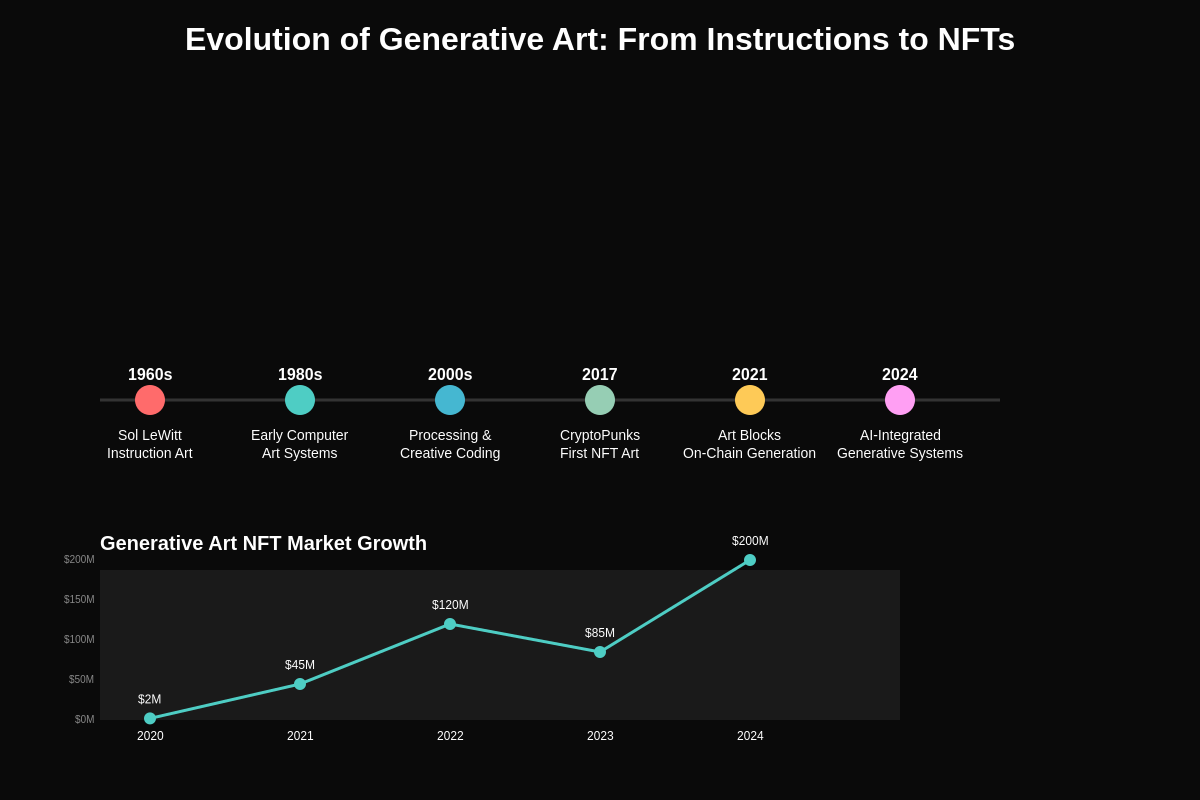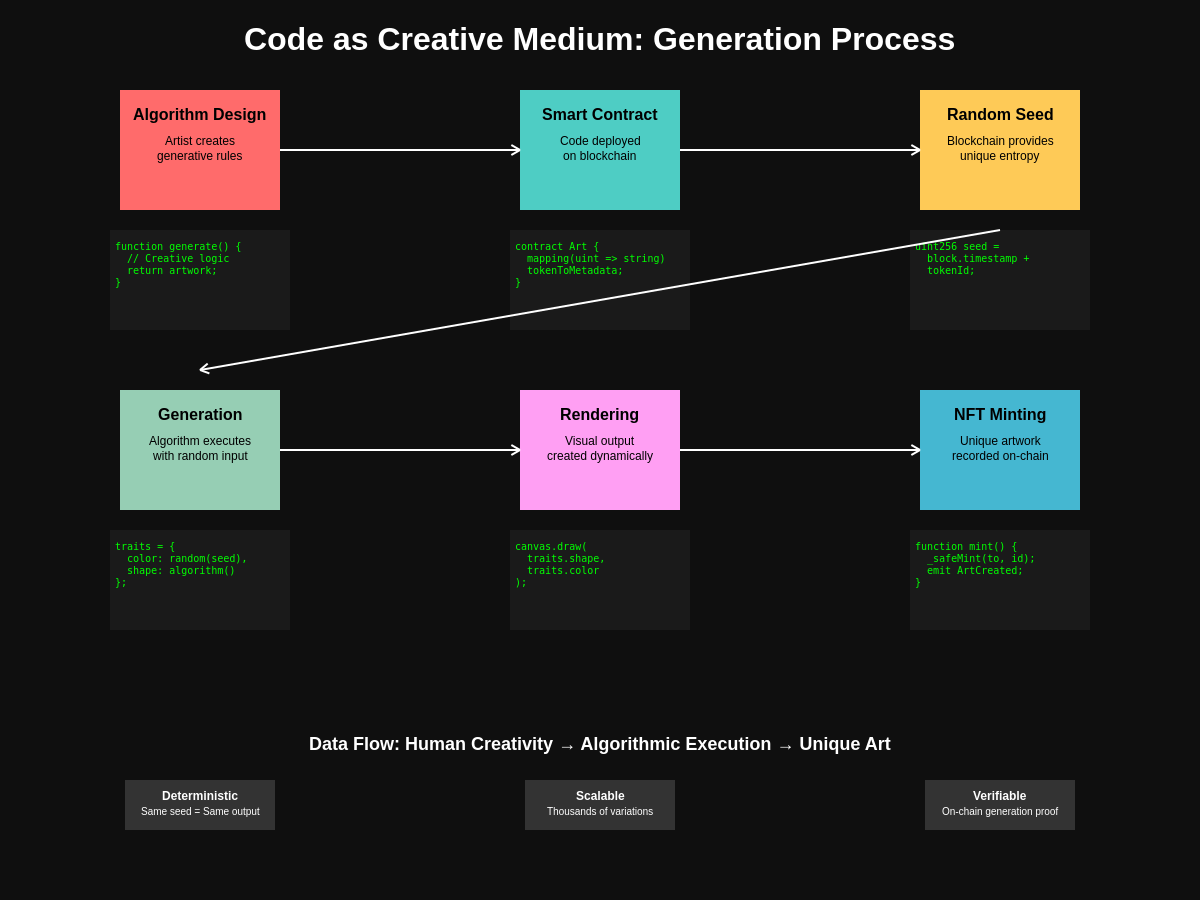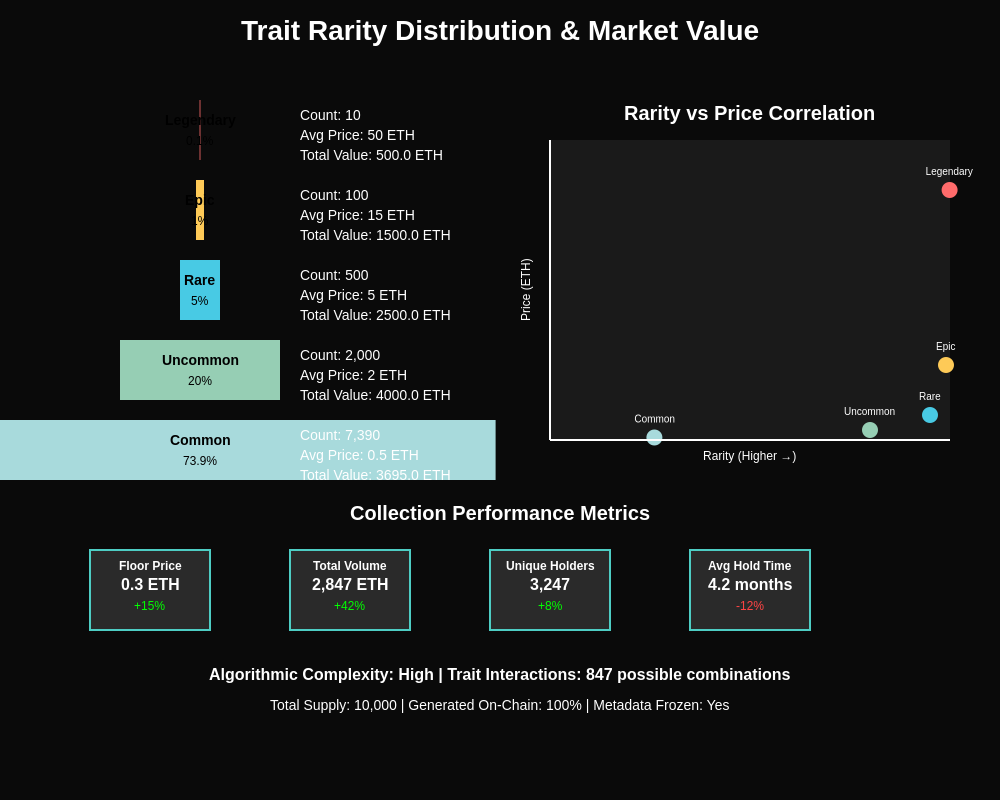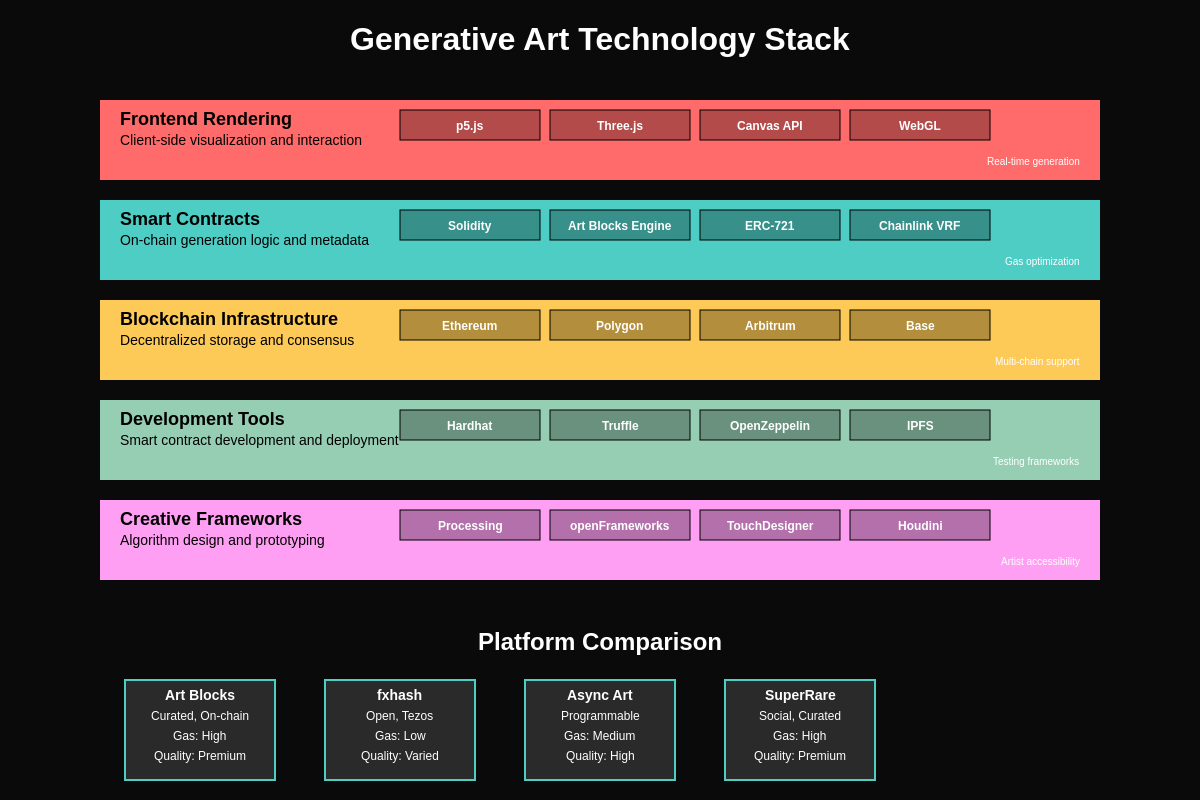Explore advanced trading strategies and technical analysis tools on TradingView’s platform to better understand crypto art market dynamics.
The Algorithmic Renaissance
Generative art has emerged as one of the most intellectually compelling and commercially successful categories within the NFT ecosystem, representing a fundamental shift in how we conceptualize artistic creation, ownership, and the relationship between technology and creativity. This movement combines traditional artistic principles with computational algorithms, creating artworks that exist at the intersection of human creativity and machine execution, where code itself becomes the primary creative medium rather than merely a tool for artistic expression.

The rise of generative art NFTs has coincided with broader technological developments in blockchain infrastructure, smart contract capabilities, and artistic software tools, creating an environment where artists can embed their creative processes directly into the blockchain while maintaining provenance, authenticity, and scarcity through cryptographic mechanisms. This convergence has enabled new forms of artistic expression that were previously impossible or impractical, while simultaneously creating new markets for digital art that operate according to different economic principles than traditional art markets.
The philosophical implications of generative art extend beyond mere technological innovation to encompass fundamental questions about authorship, creativity, and the nature of art itself. When an artist creates a generative algorithm that produces thousands or millions of unique variations, traditional notions of singular artistic works are challenged, replaced by concepts of artistic systems, creative frameworks, and algorithmic authorship that reflect the collaborative relationship between human intention and computational execution.
Historical Foundations and Technological Evolution
The roots of generative art predate the digital age by decades, with early pioneers like Sol LeWitt creating instruction-based artworks in the 1960s that anticipated many of the conceptual frameworks that define contemporary algorithmic art. These early works established the principle that artistic value could reside in the conceptual framework or rule system rather than in the specific execution of individual pieces, creating a foundation for understanding art as a system of instructions that could be interpreted and executed by different agents, whether human assistants or computer algorithms.
The transition from analog instruction-based art to digital generative systems began in earnest during the 1980s and 1990s as personal computers became more powerful and accessible to artists. Early digital pioneers like Manfred Mohr, Frieder Nake, and Georg Nees developed computational approaches to art creation that utilized mathematical functions, random number generation, and algorithmic processes to create visual compositions that could not have been produced through traditional manual techniques.
The development of programming languages and environments specifically designed for creative coding, including Processing, openFrameworks, and p5.js, democratized generative art creation by providing artists with accessible tools for translating creative concepts into executable code. These platforms lowered the technical barriers to entry while maintaining sufficient flexibility to support sophisticated artistic projects, enabling a broader community of artists to engage with computational creativity.
The emergence of blockchain technology and NFTs created new possibilities for generative art by providing mechanisms for creating provably scarce digital objects while embedding the generative process itself into the ownership and distribution system. This technological convergence enabled artists to create works where the generation process, the resulting artwork, and the ownership record all exist as integrated components of a single cryptographic system.
Smart Contract Architecture and On-Chain Generation
The technical architecture of generative art NFTs represents a sophisticated integration of artistic vision, computational efficiency, and blockchain constraints, requiring artists and developers to balance creative ambitions with the practical limitations of smart contract execution environments. Most successful generative art projects utilize hybrid approaches that combine on-chain metadata storage with deterministic generation algorithms that can reproduce identical results across different execution environments.

Smart contracts for generative art typically store essential parameters, random seeds, and generation rules on-chain while maintaining the capability to reconstruct the complete artwork using these stored elements. This approach ensures that the artistic work remains permanently accessible and reproducible even if external hosting services become unavailable, addressing one of the fundamental challenges of digital art preservation and authenticity verification.
The gas cost considerations inherent in blockchain execution have driven innovations in algorithmic efficiency and creative constraint, with artists developing techniques that maximize visual complexity while minimizing computational overhead. These constraints have become creative drivers rather than limitations, pushing artists to develop elegant solutions that demonstrate both technical sophistication and aesthetic refinement within the bounded environment of smart contract execution.
Advanced generative art platforms have implemented sophisticated randomness distribution systems that ensure fair and unpredictable trait distribution across large collections while maintaining the deterministic reproduction capabilities essential for NFT authenticity verification. These systems often incorporate multiple sources of entropy, including block hashes, transaction timestamps, and pseudorandom number generators to create robust randomness that cannot be easily manipulated by collectors or market participants.
Artistic Methodologies and Creative Frameworks
Contemporary generative art encompasses a diverse range of methodological approaches, from mathematical function visualization and chaos theory exploration to machine learning model interpretation and natural phenomenon simulation. Each approach brings distinct aesthetic qualities and technical requirements that influence both the artistic outcomes and the collector experience, creating different value propositions within the broader generative art market.
Mathematical and algorithmic approaches often draw inspiration from geometric principles, fractal mathematics, and complex systems theory to create artworks that reveal hidden patterns and emergent behaviors within computational systems. Artists working in this domain frequently explore the aesthetic potential of mathematical concepts like cellular automata, strange attractors, and recursive functions, creating visual representations of abstract mathematical relationships that might otherwise remain invisible.
Data-driven generative art utilizes external datasets as creative inputs, transforming information about weather patterns, financial markets, social media activity, or other data sources into visual compositions that reflect the underlying patterns and relationships within the source data. These approaches create artworks that serve as both aesthetic objects and data visualizations, offering viewers insights into complex information systems through artistic interpretation and creative presentation. The integration of live market data from TradingView enables artists to create dynamic pieces that respond to real-time cryptocurrency price movements and trading volumes.
Machine learning and artificial intelligence approaches to generative art involve training computational models on large datasets of images, texts, or other creative works, then using these trained models to generate new content that exhibits characteristics derived from the training data while maintaining novel and unpredictable elements. These approaches raise interesting questions about creativity, originality, and the relationship between human and machine intelligence in artistic production.
Procedural and rule-based systems create artworks through the systematic application of defined rules and procedures, often incorporating elements of randomness and emergent behavior that produce outcomes that surprise even their creators. These systems demonstrate how simple rules can generate complex and visually compelling results, reflecting principles observed in natural systems like crystal growth, biological development, and ecosystem evolution.
Market Dynamics and Collection Economics
The economics of generative art NFT collections operate according to principles that differ significantly from both traditional art markets and other categories of NFTs, creating unique dynamics around pricing, rarity, and collector behavior. The programmatic nature of generative art enables the creation of large collections with systematically varied traits and characteristics, supporting complex rarity models and economic structures that would be impractical for manually created artworks.

Trait rarity systems in generative art collections typically involve multiple layers of scarcity, including both absolute rarity based on mathematical probability and perceived rarity based on aesthetic desirability and cultural significance. The most successful collections balance mathematical rarity distribution with intuitive aesthetic appeal, ensuring that statistically rare pieces also tend to be visually distinctive and culturally valuable within the collecting community.
The pricing dynamics of generative art collections reflect both the underlying artistic merit of the generative system and the specific characteristics of individual generated pieces, creating markets where floor prices establish baseline valuation for the artistic concept while premium pieces command significantly higher prices based on their unique aesthetic qualities and rarity profiles. This dual pricing structure enables collectors to participate at different economic levels while maintaining potential for value appreciation across the entire collection.
Secondary market behavior in generative art collections demonstrates sophisticated collector understanding of both artistic and technical factors that contribute to long-term value, with successful pieces typically exhibiting strong aesthetic appeal, technical innovation, and cultural significance within the generative art community. The most valuable pieces often achieve recognition not only for their individual aesthetic qualities but also for their representation of significant moments or innovations in the evolution of generative art as a medium.
The emergence of algorithmic trading strategies specifically designed for NFT markets has created new dynamics around collection pricing and liquidity, with automated systems analyzing trait distributions, historical sales data, and market sentiment to identify arbitrage opportunities and pricing inefficiencies across different generative art collections.
Technical Innovation and Platform Development
The infrastructure supporting generative art NFTs has evolved rapidly to address the unique technical requirements of on-chain art generation, storage, and display, resulting in specialized platforms and tools that optimize for the specific needs of algorithmic art creators and collectors. These developments have enabled increasingly sophisticated artistic projects while improving the reliability and accessibility of generative art experiences for mainstream audiences.

Rendering optimization techniques have become essential for ensuring that generative artworks display consistently across different devices, browsers, and viewing contexts while maintaining the visual fidelity intended by the artist. Advanced projects implement multiple rendering pathways, progressive loading systems, and adaptive quality settings that provide optimal viewing experiences regardless of the technical capabilities of the viewing platform.
Metadata standards for generative art have evolved to accommodate the complex trait systems, generation parameters, and technical specifications that define individual pieces within large algorithmic collections. These standards enable marketplaces, galleries, and analysis tools to properly categorize, search, and display generative artworks while preserving the technical information necessary for authentication and reproduction.
Interactive generative art represents an emerging category that incorporates user input, environmental data, or temporal elements into the generation process, creating artworks that evolve over time or respond to external stimuli. These projects push the boundaries of what constitutes a fixed artistic work while exploring new possibilities for collector engagement and artistic expression within the constraints of blockchain-based ownership models.
Cross-chain compatibility initiatives are enabling generative art projects to operate across multiple blockchain networks, providing artists with greater flexibility in choosing technical platforms while enabling collectors to participate regardless of their preferred blockchain infrastructure. These developments reflect the broader maturation of the NFT ecosystem and the recognition that artistic innovation should not be constrained by technical platform limitations.
Cultural Impact and Artistic Recognition
The growing cultural recognition of generative art as a legitimate artistic medium has been accelerated by the commercial success and technical innovation demonstrated within NFT markets, leading to increased institutional attention, museum acquisitions, and academic study of computational creativity. This recognition represents a significant shift in how traditional art institutions understand and value digital artistic practices that were previously marginalized or overlooked.
Museum collections have begun incorporating generative art NFTs as permanent acquisitions, recognizing both their artistic merit and their historical significance as examples of early 21st-century digital culture. These institutional acquisitions validate generative art as culturally significant while raising important questions about digital art preservation, display methodologies, and the long-term stewardship of blockchain-based artworks.
The integration of generative art into traditional gallery exhibitions has required new approaches to artwork presentation, interpretation, and sale, with galleries developing expertise in blockchain technology, digital display systems, and the unique aspects of algorithmic art that distinguish it from other forms of digital media. These developments have created new career opportunities and professional specializations within the art world while expanding the audience for contemporary digital art.
Educational institutions have incorporated generative art and creative coding into their curricula, recognizing the importance of computational literacy in contemporary artistic practice while providing students with the technical skills necessary to participate in emerging digital art markets. These educational initiatives are creating a new generation of artists who understand both traditional artistic principles and contemporary technological capabilities.
The influence of generative art aesthetics has extended beyond the NFT space to impact broader design trends, user interface development, and visual communication strategies across various industries. The distinctive visual languages developed within generative art communities have proven influential in contexts ranging from fashion and product design to architectural visualization and data presentation.
Technological Challenges and Innovation Opportunities
The technical infrastructure supporting generative art NFTs continues to face significant challenges related to scalability, sustainability, and long-term preservation, driving ongoing innovation in blockchain technology, storage systems, and computational efficiency. These challenges represent both immediate practical concerns and longer-term strategic considerations for the sustainable development of digital art markets.
Environmental sustainability concerns related to blockchain energy consumption have motivated the development of more efficient consensus mechanisms and the migration of NFT projects to proof-of-stake networks with significantly lower environmental impact. These transitions reflect growing awareness of environmental responsibility within the digital art community while maintaining the security and decentralization properties essential for NFT authenticity and ownership verification.
Decentralized storage solutions are being developed to address concerns about the long-term availability and integrity of generative art assets, with projects implementing IPFS, Arweave, and other distributed storage systems to ensure that artworks remain accessible even if centralized hosting services become unavailable. These initiatives reflect recognition that true digital art ownership requires robust preservation systems that operate independently of any single service provider.
Interoperability standards are being developed to enable generative artworks to function across different blockchain networks, display platforms, and technical environments while maintaining their essential characteristics and authenticity properties. These standards are essential for ensuring that generative art NFTs can adapt to evolving technological landscapes without losing their artistic or economic value.
The development of new programming languages and execution environments specifically optimized for artistic creation is enabling more sophisticated generative art projects while reducing the technical barriers for artists who want to engage with blockchain-based creative systems. These tools represent recognition that artistic applications have unique requirements that may not be well-served by general-purpose development platforms.
Future Trajectories and Emerging Paradigms
The future development of generative art NFTs is likely to be shaped by advances in artificial intelligence, virtual and augmented reality technologies, and evolving blockchain infrastructure that enables new forms of artistic expression and collector engagement. These technological developments will create opportunities for artists to explore previously impossible creative territories while presenting new challenges related to authenticity, ownership, and cultural meaning.
Artificial intelligence integration represents one of the most significant opportunities for generative art evolution, with machine learning models enabling new approaches to content generation, style transfer, and interactive creativity that blur the boundaries between human and machine authorship. These developments raise fundamental questions about creativity, originality, and the role of human intention in artistic production while creating new aesthetic possibilities that could not be achieved through traditional algorithmic approaches.
Virtual reality and spatial computing platforms offer new contexts for experiencing generative art, enabling immersive environments where algorithmic processes create three-dimensional spaces, interactive experiences, and temporal artworks that evolve over time. These platforms provide opportunities for generative artists to explore new dimensions of creativity while creating more engaging and memorable experiences for collectors and viewers.
The integration of Internet of Things devices and real-world data sources creates possibilities for generative artworks that respond to environmental conditions, social media activity, financial market movements, or other external stimuli, creating dynamic artworks that reflect the complex interconnections between digital and physical reality. Analysis of cryptocurrency market patterns could enable artworks that visualize market sentiment and trading dynamics in real-time.
Cross-reality experiences that bridge virtual and physical spaces represent another frontier for generative art development, with projects exploring how algorithmic processes can influence both digital displays and physical installations, creating hybrid artworks that exist simultaneously across multiple reality contexts while maintaining coherent aesthetic and conceptual frameworks.
The development of decentralized autonomous organization structures for generative art projects could enable new models of collaborative creation, community governance, and revenue distribution that involve collectors and community members as active participants in the ongoing development and evolution of artistic projects rather than passive consumers of completed works.
Economic Models and Value Creation
The economic frameworks surrounding generative art NFTs have evolved to encompass multiple value creation mechanisms that extend beyond simple ownership transfer to include community participation, utility integration, and long-term artistic development rights. These models reflect recognition that generative art projects often function as ongoing creative systems rather than static artistic objects, requiring economic structures that can accommodate continued innovation and community engagement.
Revenue sharing models between artists, platform operators, and community members have become increasingly sophisticated, with some projects implementing dynamic royalty systems that adjust based on secondary market performance, community engagement levels, and ongoing project development activities. These models attempt to align the interests of all stakeholders while providing sustainable funding for continued artistic innovation and platform development.
Utility integration has emerged as a significant trend, with generative art NFTs providing holders with access to exclusive experiences, additional artworks, commercial usage rights, or participation in related creative projects. These utility features create additional value propositions beyond pure aesthetic appreciation while enabling artists to develop ongoing relationships with their collector communities.
The development of fractional ownership systems enables broader participation in high-value generative art pieces while creating new liquidity mechanisms for collectors who want to realize partial value without transferring complete ownership. These systems reflect growing sophistication in digital asset finance while maintaining the cultural and aesthetic values that drive collector interest in generative art.
Derivative rights and commercial licensing frameworks are being developed to clarify how collectors can utilize their generative art NFTs in commercial contexts, creative projects, and derivative works while respecting the original artist’s intellectual property rights and creative intentions. These frameworks are essential for enabling the broader cultural integration of generative art while maintaining appropriate protections for artistic creators.
The emergence of DeFi protocols specifically designed for NFT markets is creating new possibilities for using generative art NFTs as collateral, liquidity provision, and yield generation, integrating artistic assets into broader cryptocurrency financial systems while maintaining their cultural and aesthetic significance.
Disclaimer: This article is for informational purposes only and does not constitute financial, investment, or legal advice. Cryptocurrency and NFT investments carry significant risks including potential total loss of invested capital. The NFT and digital art markets are highly speculative and volatile. Past performance does not guarantee future results. Always conduct your own research and consult with qualified financial advisors before making investment decisions. The author may hold positions in cryptocurrencies or NFTs mentioned in this article.